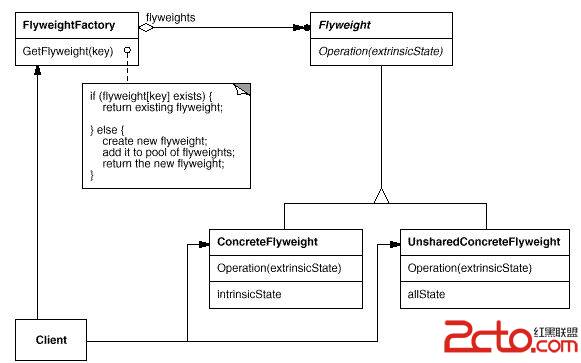设计模式-结构型-享元模式(Flyweight)
概述
运用共享技术有效地支持大量细粒度的对象。
适用情形
当都具备下列情况时,使用Flyweight模式:
1.一个应用程序使用了大量的对象。
2.完全由于使用大量的对象,造成很大的存储开销。
3.对象的大多数状态都可变为外部状态。
4.如果删除对象的外部状态,那么可以用相对较少的共享对象取代很多组对象。
5.应用程序不依赖于对象标识。由于Flyweight对象可以被共享,对于概念上明显有别的对象,标识测试将返回真值。
参与者
1.Flyweight 描述一个接口,通过这个接口flyweight可以接受并作用于外部状态。
2.ConcreteFlyweight
实现Flyweight接口,并为内部状态(如果有的话)增加存储空间。 ConcreteFlyweight对象必须是可共享的。它所存储的状态必须是内部的;即,它必须独立于ConcreteFlyweight对象的场景。
3.UnsharedConcreteFlyweight 并非所有的Flyweight子类都需要被共享。Flyweight接口使共享成为可能,但它并不强制共享。 在Flyweight对象结构的某些层次,UnsharedConcreteFlyweight对象通常将ConcreteFlyweight对象作为子节点。
4.FlyweightFactory 创建并管理flyweight对象。 确保合理地共享flyweight。当用户请求一个flyweight时,FlyweightFactory对象提供一个已创建的实例或者创建一个(如果不存在的话)。
结构图

示例代码:
package com.sql9.structured;
import java.util.ArrayList;
import java.util.List;
abstract class Flyweight
{
abstract public void doOperation(int extrinsicState);
}
class UnsharedConcreteFlyweight extends Flyweight
{
@Override
public void doOperation(int extrinsicState)
{
}
}
class ConcreteEvenFlyweight extends Flyweight
{
@Override
public void doOperation(int extrinsicState)
{
System.out.println("In ConcreteEvenFlyweight.DoOperation: " + extrinsicState);
}
}
class ConcreteUnevenFlyweight extends Flyweight
{
@Override
public void doOperation(int extrinsicState)
{
System.out.println("In ConcreteUnevenFlyweight.DoOperation: " + extrinsicState);
}
}
class FlyweightFactory
{
private List<Flyweight> pool = new ArrayList<Flyweight>();
// the flyweightfactory can crete all entries in the pool at startup
// (if the pool is small, and it is likely all will be used), or as
// needed, if the pool si large and it is likely some will never be used
public FlyweightFactory()
{
pool.add(new ConcreteEvenFlyweight());
pool.add(new ConcreteUnevenFlyweight());
}
public Flyweight getFlyweight(int key)
{
// here we would determine if the flyweight identified by key
// exists, and if so return it. If not, we would create it.
// As in this demo we have implementation all the possible
// flyweights we wish to use, we retrun the suitable one.
int i = key % 2;
return((Flyweight)pool.get(i));
}
}
public class FlyweightTest {
public static void main(String[] args) {
int[] data = {1,2,3,4,5,6,7,8};
FlyweightFactory f = new FlyweightFactory();
int extrinsicState = 3;
for (int i : data)
{
Flyweight flyweight = f.getFlyweight(i);
flyweight.doOperation(extrinsicState);
}
}
}
结果
In ConcreteUnevenFlyweight.DoOperation: 3
In ConcreteEvenFlyweight.DoOperation: 3
In ConcreteUnevenFlyweight.DoOperation: 3
In ConcreteEvenFlyweight.DoOperation: 3
In ConcreteUnevenFlyweight.DoOperation: 3
In ConcreteEvenFlyweight.DoOperation: 3
In ConcreteUnevenFlyweight.DoOperation: 3
In ConcreteEvenFlyweight.DoOperation: 3
补充:软件开发 , Java ,




